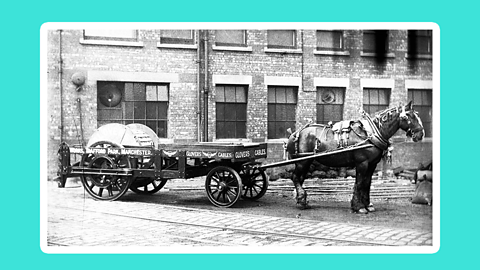
Welcome to The Regenerators.
Created in partnership with the , part of the .
Introduction
Over time, the way we’ve travelled has changed, and so has the way we power our transport.
From using coal to power steam engines to using clean energy from renewable sources to move trains, railways have not stopped improving since being invented.
The railway system has grown to meet the demand of an increasing population and it has had to keep getting faster too.
How have trains changed over time?
Watch the video below to discover how the need to move people and goods faster and further has changed our lifestyle and the environment.
Man 1: Hello and welcome to the National Railway Museum.
Railways have changed the world. The Industrial Revolution meant that coal was in high demand to power factories. Horses and canal boats could take days to move goods… but steam engines like this one could provide the power of 50 horses… to pull wagons up from the mines. But they were stuck in place, unable to move.
With steam engines on wheels, we could travel faster than ever before.
Woman 1: This is Stephenson's Rocket. In 1829 it won the Rainhill Trials… a competition to decide on the best mode of transport for the railways. It achieved a top speed of 30 miles an hour… and kick-started a frenzy of railway building.
Woman 2: Rocket inspired all future steam locomotives… and in just over 100 years, Mallard, the fastest steam engine in the world… reached 126 miles per hour in 1938.
Woman 3: With diesel, things got even faster. The Inter-City 125, the world's fastest diesel locomotive… has a top speed of 148 miles per hour. Diesel was more efficient and it was cheaper to run… but it still used fossil fuels.
Woman 4: But if it's speed you're after, the modern Japanese bullet train… can travel at speeds of up to 200 miles an hour. Not only are trains travelling faster, but they are travelling further as well.
Woman 1: Since 1994 the Eurostar has allowed us to travel internationally by rail… connecting the UK to Europe via the Channel Tunnel… one of the longest underwater tunnels in the world.
Man 1: Rocket and Mallard were powered by coal and steam… the Inter-City 125 by diesel… Eurostar by electricity. And the bullet train and The railways have shaped our world and our environment.
How will the railways of the future be powered?
The first trains
The The Industrial RevolutionA period of time from 1760 to 1840 in which scientific discoveries and technological innovations saw huge growth and change in the ways people worked and travelled. sparked changes that continue to shape the world we know today.
The invention of the steam engine meant people started to use machines to move goods and get from place to place. Coal was needed by the growing number of factories and so the steam powered LocomotiveA railway vehicle that provides the power to move a train. was developed to transport large amounts of heavy coal around the country.
This led to a rapid expansion of the railways, which brought widespread changes that shaped modern Britain as we know it.
Woman 1: Hello and welcome to the National Railway Museum.
Steam engines first arrived in the early 1800s… Stephenson's Rocket… but it was the success of in 1830 that proved steam powered locomotives… are better at pulling trains than horses.
There followed a frenzy of railway building… 22,000 miles of track in Britain alone. And in just 70 years engineers built That's almost enough to go once around the world.
Woman 2: Speeds increased from just 30 miles an hour in the 1830s…to an eye-watering 126. Achieved by the world record holding locomotive, Mallard, in 1938. But, how can steam make a huge train move?
Woman 3: The engine of a steam locomotive requires two things. Coal to burn. Thank you. And water to boil… maybe don't throw the water. Thank you.
Two people are needed to keep the locomotive moving. The driver is in charge and takes care of the speed.
Man 1: The fireman shovels coal into the firebox… of about a ton an hour… they have to do this at a rate that's the same weight as a polar bear. Inside the firebox the temperature reaches nearly 1500 degrees Celsius… that makes for very uncomfortable working conditions.
Woman 4: Hot air and smoke pass through long tubes inside the boiler and the water boils. Steam enters the cylinders, pushing hard on the pistons… first one way then the other… forwards and backwards.
The piston pushes and pulls on a rod that is connected to the wheels. The wheels turn and the train moves off down the track.
Woman 1: Steam engines ran on the rail network in Britain for almost 150 years… and it all began with Stephenson's Rocket.
ł§łŮ±đ±čłó±đ˛Ô˛ő´Ç˛Ô’s RocketDesigned by Robert Stephenson and winner of the Rainhill Trials in 1829, a competition to win the contract to produce locomotives for the Liverpool and Manchester Railway., although not the first steam locomotive, is one of the most significant, as it combined many new technologies to create a steam engine that was faster and more reliable than anything seen before.

Using the same energy source as Rocket combined with new engineering solutions such as streamliningThe act of reducing air resistance by changing the shape to increase speed and ease of movement., a locomotive called MallardA locomotive with a streamlined wedge-shaped design that holds the world speed record for steam locomotives, 126 miles per hour, achieved in 1938. set the record for fastest steam locomotive in 1938 at 126 miles per hour.

There was a general sense that life was speeding up as speed records were being set on land, sea and in the air.
History in pictures
- Image source, Science Museum Group

Image caption, A horse-drawn carriage
Before the invention of steam engines, horses were used to move wagons and carriages. They continued to be used well into the 20th century.
- Image source, Science Museum Group
Image caption, A winding engine
Winding engines pulled coal from the mines to be transported to factories.
- Image source, Science Museum Group
Image caption, Coal
There was high demand for coal to power factories and steam engines during the Industrial Revolution.
- Image source, Science Museum Group
Image caption, Stephenson's Rocket
ł§łŮ±đ±čłó±đ˛Ô˛ő´Ç˛Ô’s Rocket won the Rainhill Trials in 1829, a competition to decide on the best mode of transport for the railway.
- Image source, Science Museum Group
Image caption, Engines in steam
Steam locomotives and the growth of the rail network meant people could travel faster and further than ever before.
- Image source, Science Museum Group
Image caption, Mallard
Steam power reached its peak in 1938 with the locomotive Mallard, travelling at a top speed of 126 miles per hour.
- Image source, Science Museum Group
Image caption, Diesel engines
The High Speed Train, often known as Intercity 125, revitalised train travel by reducing journey times and reached a top speed of 148 miles per hour.
- Image source, Science Museum Group
Image caption, Passenger and commuter trains
As journey times were reduced, people were more connected. They were able to work in other cities and take holidays by train.
- Image source, Science Museum Group
Image caption, Railway posters
Posters like these advertised new services and exciting destinations.
Image caption, Eurostar
Since 1994, Eurostar has provided a direct link from the UK to mainland Europe via the Channel Tunnel, making international travel from the UK possible by rail.
1 of 10
Faster trains and a bigger rail network
Diesel fuelA combustible liquid obtained from crude oil. began to replace coal as the fuel for engines, as it was more efficient and cheaper.
Electric locomotives also became more widespread from the late 1800s. These were powered by electricity from overhead lines, a third rail or on-board energy storage, such as a battery.
The diesel-powered High-Speed Train (Intercity 125)A diesel-powered high speed train that came into service in 1976 and holds the world speed record for diesel locomotives, 148 miles per hour, achieved in 1987. significantly reduced journey times, changing the perception of rail travel in Britain.

The rail network grew as the population increased and people moved further away from cities. People relied on trains to travel to work and go on holiday.
With this expansion came international connections, allowing people to travel overseas by train. EurostarThe high speed passenger rail service that links London, UK with various European cities via the Channel Tunnel. is a high-speed train that directly links the UK to mainland Europe via the Channel Tunnel.

Modern developments in engineering have continued to affect how we travel. Most high-speed trains today are powered by electricity, and this electricity can be generated in different ways.
The environmental impact of transport
Fossil fuelsNatural fuels such as coal, oil, or gas formed from the remains of plants, animals and other organisms that died millions of years ago. have mainly powered the growth of transport and cities. Since the Industrial Revolution, most countries across the world have been using fossil fuels to provide most of their energy.
When fossil fuels are burned to make electricity they release carbon dioxide and other Greenhouse gasesGases such as water vapour, carbon dioxide and methane, in Earth’s atmosphere that trap heat., which add to the Greenhouse effectThe greenhouse effect is a heating of Earth’s surface and the air above it. It is caused by greenhouse gases in the atmosphere trapping energy from the Sun. and increases Global warmingThe increase in Earth’s average temperature, mostly caused by the build-up of greenhouse gases in the atmosphere. .
Petrol and diesel power most of our cars, lorries and trains, and transport currently accounts for around a quarter of the UK’s greenhouse gas EmissionSomething that is made and released into the environment..
Railways are an efficient mode of transport, producing less greenhouse emissions per person, because each journey is shared by tens or hundreds of people.
In the future, more and more vehicles on road and rail will be powered by Renewable energyA natural source of energy that will never run out, such as from wind, the sun, or water., which do not contribute to global warming.
How will the trains of the future be powered?
There are other ways to make electricity that do not produce harmful greenhouse gases. Renewable energy is a natural source of energy that will never run out, such as wind, solar power and water. These sources can be used to generate electricity, which can power vehicles.
The High-Speed railway link to the Channel Tunnel became the first train line in the UK to fully operate on renewable energy in 2020. In the Netherlands, wind energy powers many of the trains on the national rail network.
Other technologies are being developed to help reduce our reliance on fossil fuels too. Magnetic levitation trains (MaglevA Maglev train hovers above the track using powerful magnets in the train and the rails, reducing friction between the rails and the train. The force that repels the magnets apart and raises the train can also be used to move it forwards.) use SuperconductingSuperconductors are materials that conduct electricity with no resistance. Electromagnets made with superconducting wires are very strong and efficient. magnets to lift and propel a train along a track and do not rely on polluting fossil fuels.
Hydrogen vehiclesA vehicle that uses hydrogen as its fuel. Most are electric vehicles with an onboard fuel cell – a device that produces electricity when hydrogen (H) combines with oxygen (O) from the air. The only waste product is water (H2O). use a non-polluting chemical reaction to generate electricity, and hydrogen-powered trains have been tested on the UK’s rail network.
Design your own sustainable railway
There's more to learn
Explore more lessons and content from around the ±«Óătv.
How can we look after our environment?
GREEN CLASSROOM

What is climate change?
GREEN CLASSROOM

Year 3 - 6 and P4 - P7
GREEN CLASSROOM

More from The Regenerators
±«Óătv BITESIZE

